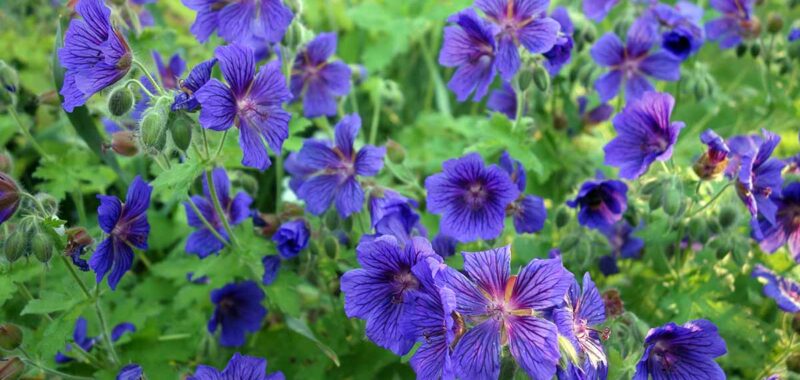Fertilizing
When grown in rich soil, hardy geraniums require little additional feeding but do benefit from having their nutrients “topped up” each year.


In springtime after new growth emerges, apply a topdressing of compost, manure, or worm castings, spreading a one- or two-inch layer of organic matter over the root zone – which also helps to retain soil moisture.
If your soil is poor quality, along with the spring topdressing, a slow release, granular fertilizer can be applied in spring using a balanced formula such as 5-5-5 (NPK) or a flower-boosting ratio like 4-6-4.


Enhanced All Purpose Plant Food
Burpee carries their own-brand Enhanced All Purpose Plant Food that can be applied according to package instructions.
Alternatively, a liquid or water soluble feed may be used. Apply in late spring when new growth is at least six inches tall and reapply after six weeks if needed.
However, it’s important to avoid overfertilizing – like most plants that enjoy lightly shady conditions and moist soil, overfertilizing is one of the main causes of sprawling, lanky growth.
If you give your cranesbill geraniums a midsummer shearing to reshape lanky limbs, a second application of slow release fertilizer can be applied after pruning. More on shearing in a bit!
Now let’s check out a few noteworthy varieties.
Cultivars to Select
With dozens of cultivars available, there’s plenty of choice. Here are a few popular options to consider starting with.
Boom Chocolatta
Loaded with masses of mauve flowers, ‘Boom Chocolatta’ also sports gorgeous foliage in chocolaty bronze.


‘Boom Chocolatta’
The mounding, upright growth is ideal for mass planting or as a filler in beds and borders. Plants are hardy in Zones 4 to 8.
Bare root plants are available at Burpee and in one-gallon containers at Nature Hills Nursery.
Havana Blues
The unique coloring of ‘Havana Blues’ features large, pretty blue mauve flowers with magenta veining and new foliage of bright chartreuse.


‘Havana Blues’
A tidy, low growing cultivar with a vigorous spread, ‘Havana Blues’ makes a good choice for ground covers, underplanting shrubs, and in cottage gardens. Hardy in Zones 5 to 8.
Bare root plants are available at Burpee.
Tiny Monster
A miniature cultivar, the compact ‘Tiny Monster’ is highly floriferous with clouds of fuchsia pink flowers and foliage with gorgeous fall shades of bronze, red, and purple.


‘Tiny Monster’
A beautiful choice for beds, borders, containers, edging, and ground covers. Hardy in Zones 4 to 8.
Plants are available in one-gallon containers at Nature Hills Nursery.
Maintenance
Cranesbill geraniums have few needs, but a little regular maintenance helps to keep plants tidy, healthy, and producing plenty of blooms.


To maintain their light, airy form with a lovely spreading habit, deadhead regularly to encourage more flowers.
Shearing
In some situations, such as too much shade or overfertilizing, they can become lanky and spent-looking, with long, leafless stems and only a few flowers at the tips.
To quickly restore a full form and encourage more flowers, shear plants back in midsummer by up to one-half of their overall size.
Winter Care
In fall after the foliage has yellowed and died back, cut back any stems still attached to the crown, cutting them close to the soil.


Rake up and dispose of any remaining plant debris.
A protective winter mulch can be beneficial to insulate the roots and protect them from heaving in freeze/thaw cycles.

